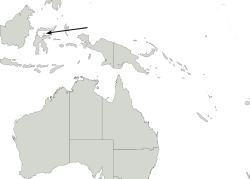| Togian Babirusa | |
|---|---|
 | |
| Scientific classification | |
| Kingdom: | Animalia |
| Phylum: | Chordata |
| Class: | Mammalia |
| Order: | Artiodactyla |
| Family: | Suidae |
| Genus: | Babyrousa |
| Species: | B. togeanensis |
| Binomial name | |
| Babyrousa togeanensis (Sody, 1949) | |
 | |
| Range (in brown) | |
The Togian babirusa (Babyrousa togeanensis), also known as the Malenge babirusa, [3] [4] is the largest species of babirusa. It is endemic to the Togian Islands of Indonesia, but was considered a subspecies of Babyrousa babyrussa until 2002. [1] Compared to the better-known north Sulawesi babirusa, the Togian babirusa is larger, has a well-developed tail-tuft, and the upper canines of the male are relatively "short, slender, rotated forwards, and always converge". [5] [6] The Togian babirusa is omnivorous, feeding mainly on roots and fallen fruit but also on worms and invertebrates. [7] Unlike other pig species, the Togian babirusa does not root at the ground with its snout when foraging, but instead can be seen pawing at the ground to uproot plants. [7]
